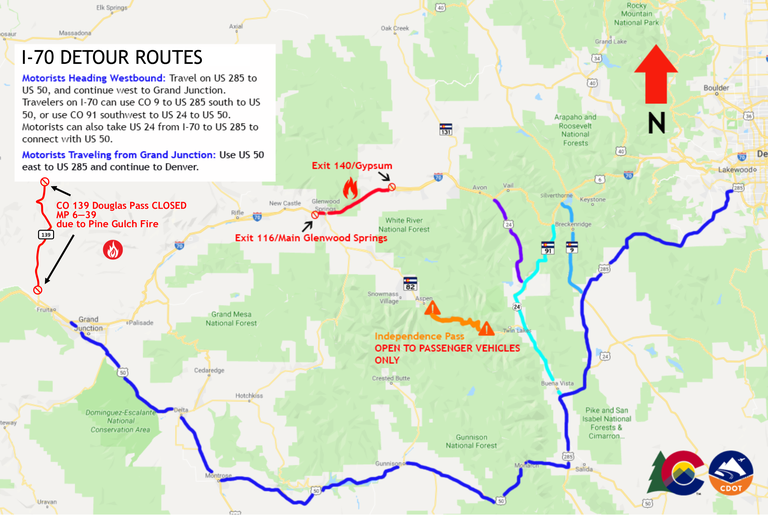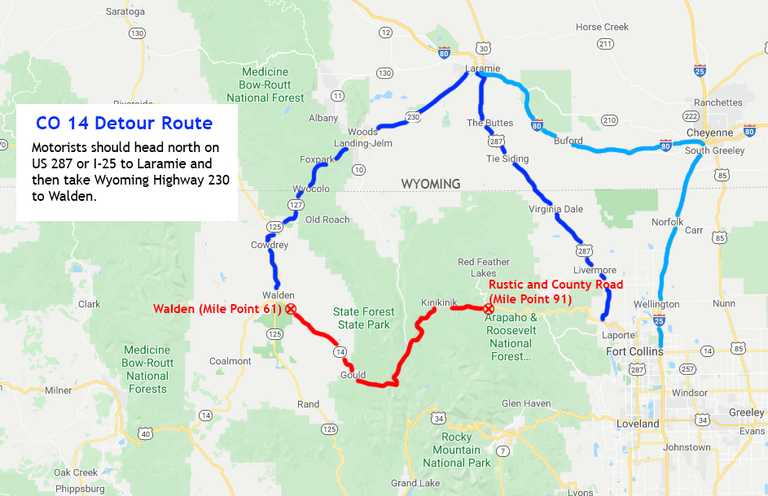Active wildfires increase and extend highway closures across Colorado
Travel Advisory
STATEWIDE ― Highway safety closures are in place due to active wildfires in several locations around the state. The closures are in response to wildfires that continue to burn or are expanding to locations near state highways. Wildfire conditions in Colorado are an active situation: fire conditions can change rapidly with closures at any time. Motorists should avoid fire areas and be prepared for new road conditions and delays. CDOT recommends that travelers “know before you go” by checking COtrip.org before traveling, having detour maps handy (see below) and packing emergency food, water, and other supplies.
Reopening for all routes below will depend on wildfire activity in the coming days. Closures include:
-
Interstate 70 in Glenwood Canyon is closed between Mile Point 116 (Glenwood Springs) and MP 140 (Gypsum) due to the Grizzly Creek Fire. The closure began Monday, Aug. 10, when the Grizzly Creek Fire began burning along the interstate. There is no estimated time of opening I-70 in Glenwood Canyon. More information about the Grizzly Creek Fire can be found here.
-
Colorado Highway 14 is closed from west of Cameron Pass and Walden (Mile Point 61) for eastbound traffic and at Rustic and County Road 69 (MP 91) for westbound traffic due to the Cameron Peak Wildfire. Please see alternate routes below. More information about the Cameron Peak Fire can be found here.
-
Colorado Highway 139 (Douglas Pass) is closed due to fire activity from the Pine Gulch Fire. The closure is north of Loma (Fruita/Grand Junction) and between Mile Point 6 and MP 39. There is no anticipated time for reopening. More information about the Pine Gulch Fire can be found here.
The Williams Fork Fire in Grand County is burning near US Highway 40 and Colorado Highway 9, north of I-70, but is not impacting state highways at this time. More information about the Williams Fork Fire can be found here.
CDOT urges drivers to take recommended detours (see below) and not rely on mapping apps that may take motorists on forest roads and over mountain passes. Remote, rugged routes are not built for heavy traffic or for two-wheel drive vehicles.


DETOUR ROUTES
CDOT recommends that travelers plan for delays when using detour routes and possible construction impacts on US and state highways. Please also check COtrip.org for the latest road conditions.
I-70
-
I-70 through traffic: CDOT recommends a southern detour route, due to construction on commonly used northern alternate routes. Drivers should anticipate additional traffic on these routes. CDOT has paused some construction projects in order to accommodate detour traffic. CDOT discourages travelers from using highways north of I-70 as a through route, due to construction zones (even if projects are paused during the closure).
-
WESTBOUND I-70: Denver metro area motorists can travel on US 285 to US 50, and continue west to Grand Junction. Travelers on I-70 can use CO 9 to US 285 south to US 50, or usus CO 91 southwest to US 24 to US 50.
-
EASTBOUND I-70 : Motorists traveling from Grand Junction can use US 50 east to US 285 and continue to Denver. Eastbound travelers on US 50/285 may also use US 24, CO 91 or CO 9 for destinations at or near Vail, Copper Mountain or Silverthorne.
-
Independence Pass: CO 82 between Aspen and US 24 is open with limited access and alternating traffic, controlled by flagging personnel. Motorists are advised that only passenger vehicles, such as cars, SUVs and vans are allowed. No commercial motor vehicles (CMVs), camper trailers, recreational or similar vehicles are allowed. A 35-foot length restriction is in place. Motorists should expect slow speeds, lengthy travel times and potential delays of up to two hours if traveling over Independence Pass. Campers and recreational vehicles are strongly advised to seek alternate southern routes.
-
CDOT asks that motorists not use Cottonwood Pass, Hagerman Pass, or other county or forest service roads in Eagle and Garfield counties as a detour. These roads are not built for heavy traffic or commercial oversize vehicles.
CO 14
- CDOT recommends detouring north on US Highway 287 or Interstate 25 to Laramie, Wyoming, and then traveling on Wyoming Highway 230 to Walden, Colo.
CO 139
-
CDOT recommends traveling on CO 9 or CO 131 to access US Highway 40, or to travel in reverse from NW Colorado to points south or the recommended detour around the I-70 closure. CDOT advises commercial traffic to use CO 9 instead of CO 131, for safety purposes. Please note that while CO 13 is open at this time, it is not a recommended detour due to construction. Oversize commercial vehicles are not allowed on CO 13 due to construction restrictions.
ABOUT CDOT
CDOT has approximately 3,000 employees located throughout Colorado, and manages more than 23,000 lane miles of highway and 3,429 bridges. CDOT also manages grant partnerships with a range of other agencies, including metropolitan planning organizations, local governments and airports. It also administers Bustang, the state-owned and operated inter-regional express service. Gov. Jared Polis has charged CDOT to further build on the state’s multimodal mobility options.
